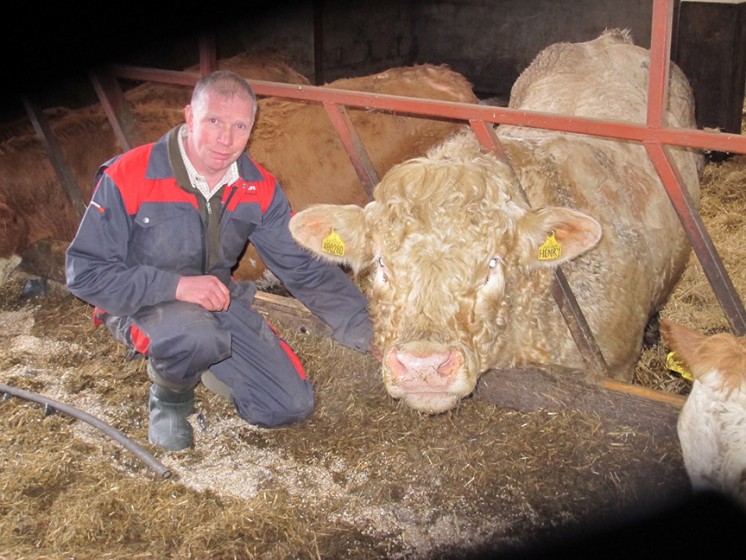Genetics + nutrition + management to maximise the number of kilos per cow as quickly and efficiently as possible
Factfile
Callum Keir, Cairncoullie, Kildrummy, Alford
500 acres including 150 acres spring barley
120 Simmental cross breeding females put to Charolais, split calving herd, all progeny finished
200 stores purchased annually and finished
200 ewes, all progeny finished
One part time employee,
Charolais has been the terminal sire at Cairncoullie for over 30 years, and without question will continue that role in future regardless of processors’ new weight limits. “We run a high input, high output unit, and our priority is to maximise the number of kilos per cow as quickly and efficiently as possible,” Callum Keir explains.
“Charolais with its unbeatable weight for age is vital to doing that job together with detailed management and accompanying nutrition which is resulting in our cattle already arriving within processors new specification.
Cairncoullie herd performance 2014/15
| Finished
Dwt (kg) |
Finished age (months) | |
| Charolais cross steers ave | 385 | 20 – 21 |
| Charolais cross heifers ave | 368 | 18 – 19 |
“All Charolais cross steers and a portion of the heifers are sold deadweight, some butcher type heifers are traded liveweight at Thainstone mart where they frequently are found within the day’s top prices.”
Keys to Cairncoullie success
Genetics: “The selection process is initially based on kill sheet observations,” Callum explains. “For example, if a portion of same sired calves were failing to grade within the grid specification, then we would look for a new bull with in a bigger muscle area. We also go for longer type Charolais bulls and they must be reared on forage and fibre based diets. The latest additions were sourced from the Thurso herd.”
Nutrition: “Diets are all home mixed using the same basic ingredients – home-grown forage and cereals combined with cost effective bought in blends. The key is formulating diets specific to age, weight and gender, consequently they are easier to manage in groups and offer flexibility to vary starch and protein levels at key stages of development,” says Callum. “Harbro’s David MacKenzie manages the diets and calls in on a regular basis to monitor the farm’s data.” The diets feature the following
- Calves: low-starch creep feed to avoid early fat deposition.
- Yearlings: reasonably high protein diet, 15% to 17% CP, with limited starch, to encourage lean growth and frame development.
- Cattle are turned out for a limited three month grazing period and set stocked, followed by housing in late July and introduced to full finishing rations after they reach 500kg liveweight.
- Steers: low protein, high starch finisher.
- Heifers: higher protein, lower starch finisher.
- Both steer and heifer diets are formulated with limited forage and balanced with cereal and dark grains in order to achieve the correct fat cover and meat yield.
Cairncoullie herd diets
| DM % | ME/kg DM | CP% | FCR | Main diet components | |
| Calf creep | 86 | 13 | 17 | 3.5 : 1 | Maxammon barley, Gramp Blend and Minerals, Yea-sacc, Rumitech |
| Yearling steer | 48 | 12.6 | 15 | 9 : 1 | TMR – pit silage, Maxammon barley, Gramp Blend and Minerals, Yea-sacc, Rumitech |
| Yearling heifer | 42 | 12.5 | 15.5 | 8.8 : 1 | As above |
| Finishing steer | 86 | 12.9 | 13 | 8.5 : 1 | TMR – straw, Maxammon barley, Propcorn barley, Gramp Blend and Minerals, Yea-sacc, Rumitech |
| Finishing heifer | 86 | 12.8 | 15 | 8.4 : 1 | As above |
Source: Cairncoullie/Harbro
Management: “We try to pay attention to detail at every turn and manage the herd by a health plan, testing and vaccinating for infections, ensuring cows energy requirements are met and by knowing their mineral status . They calve down fit not fat and are literally able to calve themselves which is really important since I’m totally responsible for all the stock work. We give the heifers the best chance possible by running them in a separate group until second calving.
“Grampian Super Suckler Minerals have been used for a number of years which have been balanced to make up for shortfalls in local trace element deficiencies which ensure we have productive cows and healthy new born calves that are able to reach their potential. We also feed Omega 25 at 150g per head which is a high fish oil product to ensure cows come into heat quicker.
“We target a tight calving pattern: the spring calving herd is achieving between 75% to 85% within the first six weeks and the entire portion within 11 weeks. Similarly, 80% of the autumn calving herd calve within the first six weeks.”
Callum is also focused on young bull management. “Charolais bulls are purchased at 14 to 16 months; in their first working year we introduce them to the same number of cows as age in months, for example 20 cows at 20 months of age. We find this regime helps to extend their working life to eight to nine years.”
He adds: “We’re continually looking at ways to improve herd efficiency. For example, shortening the grazing season and introducing the steers to ad lib barley three months earlier not only helped us to achieve target deadweight sooner, but resulted in freeing up more quality grass for lamb finishing and reducing fertiliser requirements.”
Categories: Commercial, News
Harestone Charolais herd scoops top awards » « Welshpool Sale 4 February 2016
